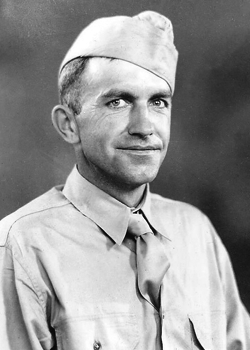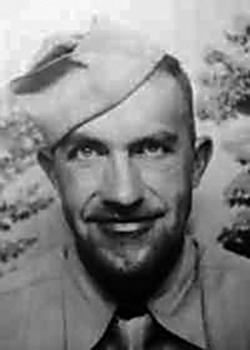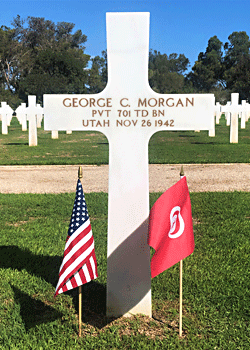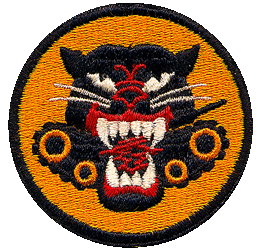 George C. Morgan
George C. Morgan
Biography: George Clifford Morgan was born on September 29, 1908, in Junction City, Kansas. He was the son of William Perkins Morgan “Will” and Emma Mary Bame and was one of 10 children (3 brothers and 6 sisters) born to the couple. He attended local schools through the grammar levels and worked on the family farm.
Around 1937, he moved out to Provo, Utah, and was lodging with his brother Edward, in the home of Francis Duwalder. We are not sure but this may have been a relative on his mother’s side since we know there were other Bame family relatives living in the Orem and Provo, UT, areas. He was initially working as a farmer but his draft registration card from October 1940, states that he was self-employed at the time and living in Burley, Idaho. At some point, he would go into the restaurant and filling station business on West Center Street in Orem. Just prior to his induction into the Army, he was employed by Monte Young, who was in the carnival business.
Service Time: George entered the service on June 3, 1942, at Fort Douglas, UT. After his basic training, he was sent overseas as a replacement and was assigned to C Company of the 701st Tank Destroyer Battalion. The 701st may have still been in the United Kingdom or possibly already in North Africa when he joined them.
 The 701st had shipped out from the New York port on May 31, 1942, and arrived at Belfast, Northern Ireland, on June 11th. Companies B and C, along with one platoon of Recon Company, participated in the Operation Torch landings on November 8th, near Oran, Algeria, and advancied toward Tunisia, beginning on November 16th. C Company was called on to protect the right flank of the 2nd battalion of the 13th Armored Regiment, while it made a wide envelopment of the town of Medje.
The 701st had shipped out from the New York port on May 31, 1942, and arrived at Belfast, Northern Ireland, on June 11th. Companies B and C, along with one platoon of Recon Company, participated in the Operation Torch landings on November 8th, near Oran, Algeria, and advancied toward Tunisia, beginning on November 16th. C Company was called on to protect the right flank of the 2nd battalion of the 13th Armored Regiment, while it made a wide envelopment of the town of Medje.
While moving to join the 2nd battalion, on November 26, Thanksgiving Day, 1942, the company was strafed by an American P-38 squadron from the 14th Fighter Group (formerly 14th Pursuit Group) of the 12th Air Force. Seventy-five percent of the 701st’s combat vehicles were immobilized, 7 men were killed and 12 were wounded. We believe that George C. Morgan was one of the men that was killed during this “friendly fire” incident.
In the short 701st unit history, “Opening Rounds” (unknown author), the incident is described as follows; “On Thanksgiving, the 26th, C Company was switched to provide flank protection for CCB tanks trying to envelop the town. While moving to join the tankers, American P-38 Lightnings were sighted. The momentary pleasure at finally seeing an answer to the constant Luftwaffe attacks was soon shattered. The eleven Lightnings swooped down and strafed the C Company column. While the TD men dove for cover and gritted their teeth, the P-38s of the 14th Pursuit Group each made five passes. When they left, C Company was no longer a fighting unit. Seven men had been killed, twelve wounded and nine vehicles burned. Seven of the TDs were out of action and almost every other vehicle damaged. Lack of adequate air-ground training for the Air Corps pilots had led to the tragic error and turned Thanksgiving into disaster at a critical juncture in the campaign. But, Capt. Redding and C Company were not through. Hard work and ingenuity during the next three days got seven of the 75mm half-tracks and three of the 37mm TDs operational again. In the process, Capt. Redding and his men molded a new unity of purpose. By the 30th, C Company was ready again.”
The book, “A Common Soldier”, written by author J. Steve Biggs, tells the story of his father, Lawrence F. Biggs, who also served in C Company. The book also includes an account of the incident on the 26th. Thankfully Lawrence was one of the lucky ones that survived but he was injured. A bullet pierced his helmet, sliced into his scalp, and exited out the back of his helmet but his injury wasn’t too serious and he was able to continue with the unit.
 George was temporarily buried in the area and later re-interred in the North Africa American Cemetery and Memorial, located in Carthage, Tunisia, Plot E, Row 21, Grave 8.
George was temporarily buried in the area and later re-interred in the North Africa American Cemetery and Memorial, located in Carthage, Tunisia, Plot E, Row 21, Grave 8.
Provo Daily Herald Article – Jan. 5, 1943
In an article from an unknown Kansas newspaper, a note to the family, from George’s commanding officer, Captain Frank J. Redding, is quoted as saying:“Your son was a fine soldier and his death in the face of the enemy is a loss deeply felt by all the officers and men of this organization. I hope you may draw some small consolation from the fact that he was so highly held in the esteem of his comrades”. The note had been written on December 18, 1942, but the family did not receive it until sometime in 1943.
Newspaper Article, Unknown Source – from 1943
I want to first thank George for his service and ultimate sacrifice that he paid. I also want to thank Teri Fronk for her work to document fallen WWII soldiers from Utah. Teri provided the articles, and secondary photo of George, used in this article. Thank you also to Carol Tyler of the American Battle Monuments Commission for providing the grave marker photo.
